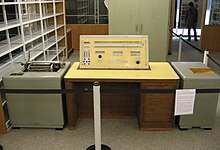ZRA 1

The Zeiss calculating machine 1 , or ZRA 1 for short , was the first mass-produced programmable digital computer in the GDR . It was developed and manufactured at VEB Carl Zeiss in Jena .
history
While the OPREMA relay computer was being tested in 1955, the developers Wilhelm Kämmerer and Herbert Kortum began to design an electronic computer system. The aim of the development should be a powerful computer with significantly more storage space for processing scientific and technical tasks with high reliability. The program should be created externally so that the system did not stand still during programming, as was the case with the OPREMA. This is how the plan for a programmable, bit-serial one-address machine with a word length of 48 bits was created. Kämmerer provided the theoretical basis, while Kortum took over the project management. Johannes Krötenheerdt from the Martin Luther University Halle-Wittenberg was involved in the development, production and programming of the ZRA 1 .
Technical specifications
Since available at this time transistors were considered not reliable enough, it was decided to semiconductors - diodes and ferrite - ring cores as building blocks for logic circuits and electron tubes for signal conditioning and amplification. At the end of 1956 the ZRA 1 was essentially completely assembled. However, difficulties arose with the disk memory intended as the main memory. In 1958, the drum memory developed by Nikolaus Joachim Lehmann at the TH Dresden with a capacity of 4096 48-bit words was used for this purpose. The drum rotated at 12,000 revolutions per minute, which enabled an average access time of 2.5 milliseconds. A total of 12,000 germanium diodes (OA 170), 8500 ferrite cores and 720 electron tubes (PL84) as well as some relays to control the peripheral devices were used. A punch card reader was used as the input device , from which programs and data were read into the main memory. The printing unit of an existing tabulating machine was used to output the calculation results . The system required a space of at least 6 × 8 m², the power consumption was 19 kilowatts .
Structurally, it was a Von Neumann architecture with a shared program and data memory. An accumulator , called an arithmetic register here, was available as a one-address machine . In addition to the main memory, there were eight so-called high-speed memories ( processor registers in today's terminology) in which operands that are often required could be stored; this circumvented the relatively long access times of the drum store. There was also a program counter and index register; there was no stack .
The instruction set comprised all instruction groups of today's CPUs :
- Transfer instructions for fetching and storing data in the main memory and the processor registers
- Arithmetic instructions for the basic arithmetic operations , each with fixed and floating point numbers , incrementing
- The logical operations conjunction and disjunction as well as shift operations
- Test commands such as result negative . As a special feature, there were test commands for querying some switches on the control panel, with which the program flow could be influenced from there.
- Commands for the program run, such as conditional and unconditional jumps, conditional and unconditional program stop
- Output commands for the printer - input commands were not required. The only possible input device, the punch card reader, was started manually from the control panel.
The commands and data were punched in binary code on punch cards with special punches ; one card held twelve words. A compiler for a subset of Algol 60 was later developed.
Some processing times:
- Organizational operations: 0.5 to 2.5 milliseconds (ms)
- Fixed point operation: addition 3.8 ms, multiplication 7 ms, division 14 ms
- Floating point operation: addition 7 ms, multiplication 8 ms, division 14 ms
This allows an average performance of around 120 FLOPS to be estimated. For comparison: A PC commercially available in 2005 had around three billion FLOPS.
use
In 1960 the ZRA 1 was exhibited at the Leipzig spring fair. At the same time, series production began at the Zeiss subsidiary in Saalfeld , where a total of 31 systems were manufactured. The computers were distributed among the institutions by a commission from the Research Council of the GDR :
- 15 computers were sent to academy and research institutes,
- 10 at universities (including the first in 1961 at the Technical University of Magdeburg ) and
- 7 systems including the prototype were used in industry.
At the end of 1963 the manufacture of the computer was discontinued in favor of the fully transistorized digital computer Robotron 100 developed by VEB Electronic Calculating Machines in Karl-Marx-Stadt . A political decision was to discontinue work on the successor model ZRA 2 , which was already well advanced at that time - the development of digital computers was to be concentrated at the Robotron combine . The use of the machines lasted until the end of the 1960s, when the Robotron 300 , which were built from 1968, became available in greater numbers.
Despite the small number of units, the ZRA 1 had a great influence on IT in the GDR, as many first-generation data processing specialists had their first practical experience with digital computers on a ZRA 1.
literature
- Gerhard Haas: Basics and components of electronic number calculators . Philips Technical Library, 1961. Includes a chapter on ferrite cores for logic circuits.
- Gerhard Wolf: Digital Electronics . Franzis-Verlag, Munich 1969. Contains logic circuits with ferrite cores.
- Immo O. Kerner: OPREMA and ZRA 1 - the calculating machines from Carl Zeiss Jena in computer science in the GDR - a balance sheet. GI-Edition, Bonn 2006, pp. 147–177
- Siegmar Gerber: Use of Zeiss computers for research, teaching and services in computer science in the GDR - a balance sheet. GI Edition, Bonn 2006, pp. 310-318
Individual evidence
- ↑ Zeiss computing machine ZRA1 at itz.uni-halle.de. Retrieved November 16, 2019.






